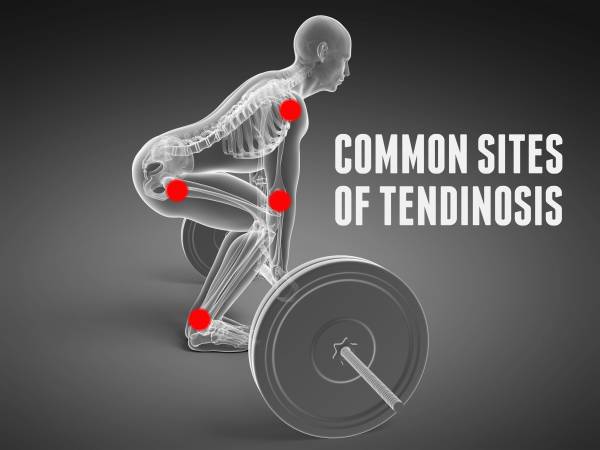I’m sure at some point in your athletic endeavours you have dealt with injury or pain. Sometimes those injuries can produce pain that doesn’t want to go away and forces you to try to find a resolution.
The first start for many people with pain is to do a Google search, check WebMD, or ask their coach what is going on. In many cases, the overwhelming diagnosis is some type of tendonitis. But this default diagnosis is a mistake. There could be many causes for your pain. Assuming the injury is inflamed and must be tendonitis is flat out wrong.
Perhaps you have taken it a step further and actually sought out some type of medical doctor in hopes to find the root causes. But even medical doctors are guilty of making what I call a “junk box” diagnosis of tendonitis.
In many cases, this leads to bad advice. People get the standard answer of, “Lay off it for a few weeks, rest, use ice, and take some anti-inflammatory medication.” In the short term you do feel better because you aren’t using the damaged area. But as soon as you get back into activity, the pain returns.
A more common (and more serious) cause of that pain is what we call tendinosis.
What is Tendinosis?
Tendinosis is degenerated tissue. Consider the following analogy:
A healthy tendon looks like pre-cooked spaghetti. It is pretty strong and takes some force to break. Under a microscope all the cells look uniform and are stacked up neatly. A tendinosis is a degenerated portion of the tendon that ends up looking like cooked spaghetti. It receives lousy blood flow and is made of weaker and inferior tissue.
“97% of all soft tissue injuries and tears happen in degenerated tissue.”
Tendinosis comes about when the surrounding areas are overloaded. It is the body’s response to the increased demand. The problem here is that it isn’t good quality tissue. Often the cells are immature and lack many of the normal attributes of a healthy tendon.
Why did the Tendinosis Happen?
The tendinosis occurred because the diagnosis and treatment plan were both completely wrong. Degenerated tissue is often overlooked in the medical world. This oversight can end up being disastrous, since 97% of all soft tissue injuries and tears happen in degenerated tissue. And as we know, tendinosis equals degeneration.
Have you ever seen someone blow out their Achilles? It sounds like a shotgun went off and leaves the person in agonising pain. The sad part is that it could have been prevented if the pain had been properly diagnosed and treated.
So now we are clear. In the majority of cases it’s not an “-itis,” it’s an “-osis.”
How Do You Know if You Have Tendinosis?
- Does the pain feel worse in the morning when you first wake up?
- Does the area feel better after it is warmed up? (This can actually be dangerous, as people will often ignore the pain because they feel better as they warm up, but all the dysfunction is still there.)
- Does the area feel beat up after use or exercise, often a lot more than the other side of the body and with some swelling?
- Is the area sensitive to the touch? If someone were to press on it, would it send you jumping away?
Many of the above symptoms are classic signs of tendinosis. An example would be in the Achilles tendon. Are your first few steps out of bed painful? This happens because the area gets a poor blood flow overnight and causes waste products to build up in the area. The longer it takes to move around and not have pain, the more severe the tendinosis may be.
See the picture for the most common places to have a tendinosis:

What Do You Do If You Have Tendinosis?
The first step is to get the problem accurately diagnosed. Once the right diagnosis is made, the resolution of the tendinosis has a high success rate with the following steps:
- Stop beating the hell out of the area. If you experience a ton of pain or dysfunction in the area and suspect it is tendinosis, the last thing you want to do is to beat up the area any more. This degeneration can be a ticking time bomb that can tear before you know it. Then the only option is surgery and the tendon never being the same again.
- Get the surrounding area treated. As I mentioned in a previous article, addressing the adhesion around the tendon will go a long way in taking the load off the tendon so it doesn’t get worse.
- Start some eccentric exercises. This will help the tendon start to regenerate and improve the overall blood flow to the area. Unfortunately just resting it won’t improve the tissue quality at all.
- Brace the area if you need to. This is a cautionary step and should only be used if absolutely necessary. The brace shouldn’t be used to help get you through your training or to allow you to do more activity.
Summary
Too many people end up getting full-blown tears because the true causes were overlooked. If you have pain and it seems like it is tendinosis, act quickly before your only option is surgery.
Further Reading:
- Why Ultrasound Is a Waste of Time When Treating Injuries
- ASimple 4-Step Mobility System for Every Lifter
- Hurt or Injured? A 3-Step Assessment and Action Plan
- New on Breaking Muscle UK Today
Photos courtesy of Shutterstock.






